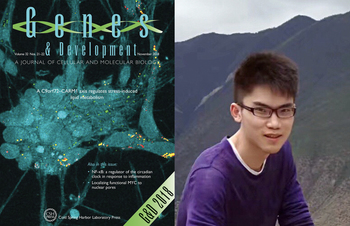Wang lab findings uncover connection between neurodegeneration and metabolism
Mutation associated with ALS causes sugar-starved cells to overproduce lipids, study led by Yang Liu shows
Finding could lead to new ways to fight this and other neurodegenerative disease, including dementia

A genetic defect tied to a variety of neurodegenerative diseases and mental illnesses changes how cells starved of sugar metabolize fatty compounds known as lipids, a new study led by researchers from the Johns Hopkins Bloomberg School of Public Health shows. The finding could lead to new targets to treat these diseases, which currently have no cure and few or no truly effective treatments.
The finding was featured on the cover of the November issue of the journal Genes & Development.
Several years ago, researchers identified a mutation in a gene called C9orf72 that’s since been associated with amyotrophic lateral sclerosis (ALS), frontotemporal dementia (FTD), Alzheimer’s disease and bipolar disorder, and other neurologic diseases. Although researchers have known that this mutation decreases the amount of the protein coded by the C9orf72 gene in cells, it’s been unknown exactly what this protein does, explains study leader Jiou Wang, MD, PhD, an associate professor in the Department of Biochemistry and Molecular Biology at the Bloomberg School.
To learn its function, the researchers created mouse cells in which C9orf72 was effectively removed, preventing the production of its protein to study what happens in cells naturally carrying the gene’s mutated form. They then compared these cells to those with the gene, looking broadly at the levels of all proteins produced in both types of cells. They studied these protein levels both under normal conditions as well as when the cells lived in media devoid of the sugar known as glucose, an important cellular energy source. Previous studies have hinted, Wang explains, that C9orf72 might play a role in how cells protect themselves from nutrient starvation stress.
When healthy cells are deprived of glucose, Wang says, they tend to make and store more lipids droplets. However, the researchers’ protein level analysis showed that when deprived of glucose, the C9orf72 knockout cells produced significantly more lipid metabolism-related proteins compared to cells with this gene. When the researchers compared the number of lipid droplets between the two types of cells in glucose-devoid conditions, the C9orf72 knockouts held significantly more. They also had more free fatty acids, the individual components that come together to form these lipid droplets.
When fatty acid levels increased, so did the levels of an enzyme called NOX2, known to cause oxidative stress that can damage cells, Wang says. NOX2 has also been shown to be elevated in patients with ALS and FTD.
To better understand why lipids increased in cells without the C9orf72 gene, the researchers looked at the two different pathways that cells use to create lipid droplets: either creating them from scratch, a process called de novo lipid biogenesis, or by digesting other components of the cell to make lipids, a process called autophagy. They found that higher amounts of the proteins associated with both routes in cells without the C9orf72 gene, suggesting that each lipid-producing pathway was upregulated.
Digging even deeper to find out how cells without C9orf72 boosted both pathways, they did another protein analysis to find which proteins are associated with C9orf72. Their search led them to CARM1, a protein known to broadly affect which genes produce proteins, and how much, through a process called epigenetic regulation that involves control of gene expression without altering DNA sequences. It turns out that C9orf72 is important for a previously unknown pathway to degrade CARM1 protein by the lysosome, the cell’s digestive organelle. Further investigation showed that in C9orf72 knockout cells, CARM1 levels increase, leading to greater expression of genes related to lipid production.
To see if these results translate to what happens in patients with C9orf72 mutations, the researchers studied cells and tissues from patients with ALS and FTD. Starving these samples of glucose led to the same results they saw in the mouse-derived cells: increased lipid levels caused by dysregulation of both lipid-producing pathways, along with increased levels of CARM1 and NOX2.
Taken together, Wang says, these results suggest that mutations in C9orf72 lead to greater amounts of CARM1, which causes cells to overproduce lipids and NOX2 in response to glucose starvation.
“Cells with this mutation act as if they’re chronically under stress, which could underlie the pathology of diseases associated with this defect,” Wang says. “Our study raises the question of whether we should be looking at problems with lipid metabolism as a potential cause for these diseases. As we learn more about this newly discovered biological pathway, it could lead to new therapeutic interventions that protect cells that carry this mutation from harm.”
“A C9orf72-CARM1 Axis Regulates Lipid Metabolism Under Glucose Starvation-induced Nutrient Stress,” by Yang Liu, Tao Wang, Yon Ju Ji, Kenji Johnson, Honghe Liu, Kaitlin Johnson, Scott Bailey, Yongwon Suk, Yu Ning Lu, Mingming Liu and Jiou Wang.
This study was supported by grants from the NIH (NS074324, NS089616), the Packard Center for ALS Research at Johns Hopkins, the ALS Association and the Muscular Dystrophy Association.
This news is adapted from the press release from the Johns Hopkins University Bloomberg School of Public Health.
